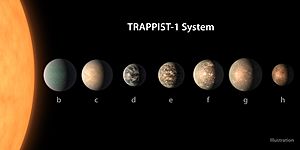TRAPPIST-1 facts for kids

TRAPPIST-1 is a special kind of star called an ultracool red dwarf. It is almost 40 light years away from our Sun. You can find it in the constellation of Aquarius.
This star is famous because it has seven planets orbiting around it. These planets are about the same size as Earth and are likely made of rock. Scientists found them between 2016 and 2017. Some of these planets might even have liquid water on their surface!
Four of these planets (named TRAPPIST-1d, TRAPPIST-1e, TRAPPIST-1f, and TRAPPIST-1g) are in the star's "habitable zone." This means they are just the right distance from their star to possibly have liquid water, which is important for life. The other three planets (TRAPPIST-1b, TRAPPIST-1c, and TRAPPIST-1h) are not in this zone, so they are less likely to have liquid water.
In August 2017, the Hubble Space Telescope looked closely at some of these planets. It found signs that there might be water in their atmospheres. This is very exciting for scientists!
Contents
What is TRAPPIST-1?
TRAPPIST-1 is much smaller and cooler than our Sun. It is called a red dwarf because it is a small, cool star that glows with a reddish light. Stars like TRAPPIST-1 burn their fuel very slowly. This means they can live for a very, very long time, much longer than our Sun.
The Seven Planets of TRAPPIST-1
Scientists have found seven planets orbiting TRAPPIST-1. All of them are similar in size to Earth. They are also very close to their star, much closer than the planets in our own Solar System are to the Sun. Because the star is so cool, even being close can put a planet in the habitable zone.
The Habitable Zone
The habitable zone is like a "sweet spot" around a star. If a planet is in this zone, it's not too hot and not too cold. This allows liquid water to exist on its surface. Liquid water is very important because all life we know of needs it to survive.
- TRAPPIST-1d, e, f, g: These four planets are in the habitable zone. Scientists are very interested in studying them to see if they could support life.
- TRAPPIST-1b, c, h: These three planets are outside the habitable zone. Planets b and c are too close to the star and might be too hot. Planet h is too far away and might be too cold.
Are the Planets Rocky?
Scientists believe these planets are mostly made of rock, just like Earth. They figured this out by measuring how much the planets pull on each other. This helps them learn about the planets' mass and density.
Looking for Water
The Hubble Space Telescope has been used to study the atmospheres of some TRAPPIST-1 planets. In 2017, it found signs that water vapor might be present. This is a big step in understanding if these planets could really have liquid water. Future telescopes, like the James Webb Space Telescope, will help us learn even more about these exciting worlds.
Images for kids
-
TRAPPIST-1 compared to the size of the Sun.
-
How the TRAPPIST-1 system compares to the inner planets of our own Solar System.
-
Planetary transits of TRAPPIST-1 over 20 days, recorded by the Spitzer Space Telescope in 2016.
-
The TRAPPIST-1 system compared to the Solar System; the orbits of its seven planets would easily fit inside the orbit of Mercury.
See also
 In Spanish: TRAPPIST-1 para niños
In Spanish: TRAPPIST-1 para niños







